




In the 17th, 18th and early 19th centuries, when natural history was still called philosophy and most naturalists were amateurs, collectors would create what they called cabinets of curiosities — accumulations of animal, vegetable, mineral and anthropological specimens to amaze and amuse.
Often these collections grew large enough to occupy entire rooms, or even buildings. In some cases, they turned out to be precursors of modern museums.
In a way, that was the kind of project seven Philadelphia men embarked on in 1812, when they rented premises over a millinery shop, gathered a few preserved insects, some seashells and not much more, and created the Academy of Natural Sciences of Philadelphia...
--"Cupboards of Curiosities Spill Over," Cornelia Dean, The New York Times
The Philadelphia Academy of Natural Sciences has a lot going for it. It is the oldest natural science research institution and natural history museum in the New World, with a history stretching back to 1812. It boasts
the Titian R. Peale Butterfly and Moth Collection, a lot of nearly 100 glass boxes containing said insects arranged in pleasingly geometric patterns by Titian Peale, son of painter and first American museologist
Charles Willson Peale (see 4th image down). It boasts fossils collected by American president and Declaration of Independence author Thomas Jefferson. It also houses an incredibly vast and utterly astounding collection of natural history artifacts, books, taxidermy, skeletons, wet specimens and more. More's the pity, then, that you would never suspect the quality and breadth of this collection by its public face, which gives one the impression that The Academy is merely a bland, second-rate natural history museum aimed at easily distractable children.
I am very pleased to report, then, that the Philadelphia Academy of Natural Sciences has used the pretext of its 200th birthday to right this wrong, and make visible its illustrious history and mind-bogglingly gorgeous collection through 2 new exhibitions--both now on view--and a new nearly 500-page luxurious book. One exhibition--"The Academy at 200: The Nature of Discovery"--displays rarely viewed specimens and artifacts from the museum stores. "Everything Under the Sun," a second exhibition, features luminous photographs by
the amazing Rosamond Purcell of a variety of the incredible artifacts and specimens hidden backstage
. The associated book is entitled
A Glorious Enterprise: The Academy of Natural Sciences of Philadelphia and the Making of American Science and features Rosamond Purcell's lavish color photographs.
Above is an excerpt from The New York Times' review of the book and exhibitions; you can read the entire piece and see the photographic sideshow (from which the above images are drawn) by clicking
here and
here, respectively. You can find out more about the book “A Glorious Enterprise"--and purchase a copy of your very own--by clicking
here. You can find out more about the exhibitions by clicking
here and
here.
Thanks so much to friend and
Morbid Anatomy Art Academy Instructor Marie Dauhiemer for sending this along!
Images top to bottom: All by
Rosamond Purcell drawn from the
New York Times slide show, and presumably featured in the book and exhibition:
- A spider crab (Libina canaliculata), collected by Joseph Leidy in Atlantic City.
- Black-backed kingfishers (Ceyx erithancus), collected by the ornithologist Rodolphe Meyer de Schauensee in Siam (now Thailand), 1937-38.
- Cone shells collected for the museum from Tanzania, Dutch New Guinea and the Palau Islands by A.J. Ostheimer III during the 1950s.
- A selection from the butterfly and moth collection of Titian R. Peale, a noted 19th century entomologist.
- A Ruby-cheeked Sunbird from Borneo, given to the Academy by Thomas B. Wilson in 1846.






























